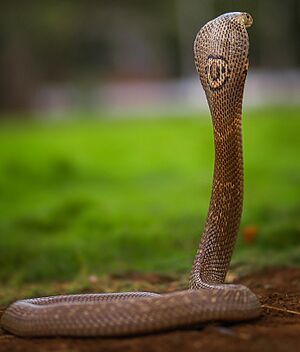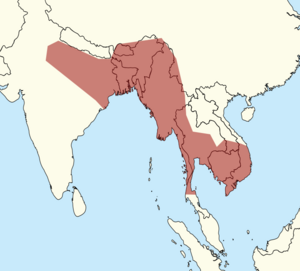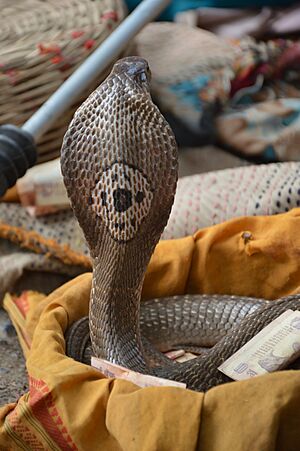Monocled cobra facts for kids
Quick facts for kids Monocled cobra |
|
|---|---|
 |
|
| Monocled cobra | |
| Conservation status | |
| Scientific classification | |
| Genus: |
Naja
|
| Species: |
kaouthia
|
 |
|
| Naja kaouthia distribution | |
The monocled cobra (Naja kaouthia) is a venomous cobra species. It is also known as the monocellate cobra or Indian spitting cobra. This snake lives across South and Southeast Asia. It is listed as Least Concern on the IUCN Red List. This means it is not currently at high risk of extinction.
Contents
About the Monocled Cobra's Name
The scientific name Naja kaouthia was first given by René Lesson in 1831. He described this cobra as a beautiful snake. He noted it was different from the spectacled cobra. The name Naja kaouthia helps scientists identify this specific snake.
Over time, scientists studied these snakes more. They found that the monocled cobra is its own distinct species. This helped avoid confusion with other similar cobras, like the Indian cobra.
What Monocled Cobras Look Like
The monocled cobra gets its name from a special mark on its hood. It has an O-shaped, or "monocle," pattern. This is different from the Indian cobra, which has a "spectacle" pattern. The spectacle pattern looks like two circles connected by a line. Cobras can spread their neck ribs to form this wide hood.
Young monocled cobras usually have similar colors. Their back can be yellow, brown, gray, or blackish. They might have faint stripes. Older snakes tend to become paler, turning brownish or olive green.
They have a black spot under their hood on each side. There are also one or two black stripes on their belly behind the hood. The rest of their belly is usually lighter than their back.
Monocled cobras have two fixed fangs at the front of their mouth. These fangs can grow quite long. Some populations of this cobra can also spit their venom.
Adult monocled cobras usually grow to be about 1.35 to 1.5 meters (4.4 to 4.9 feet) long. Their tail can be about 23 centimeters (9 inches) long. Some rare individuals can grow even larger, up to 2.3 meters (7.5 feet).
Where Monocled Cobras Live
The monocled cobra is found in many countries. These include India, China, Vietnam, and Cambodia. They also live on the Malay Peninsula. You can find them in West Bengal, Bangladesh, Bhutan, Myanmar, Laos, Nepal, and Thailand.
These snakes can live in many different places. They like areas with water, such as paddy fields, swamps, and mangroves. They also live in grasslands, forests, and even near human homes. They can be found in cities and at elevations up to 1,000 meters (3,300 feet).
Monocled Cobra Behavior and Habits
Monocled cobras are mostly active during the evening. They spend most of their time on the ground. In areas where rice is grown, they often hide in rodent burrows. These burrows are found in the small walls between fields. In these places, they can even become semi-aquatic, meaning they spend some time in water.
Young cobras mostly eat amphibians like frogs. Adult cobras hunt small mammals, other snakes, and fish. When a monocled cobra feels threatened, it usually tries to get away. However, if it cannot escape, it will raise the front part of its body. It will spread its hood and often hiss loudly. Then it will strike to bite and defend itself.
They often hide in tree holes. They also like places where there are many rodents, as rodents are a good food source. As mentioned, some monocled cobras can spit venom. This is why they are sometimes called "Indian spitting cobras."
Monocled Cobra Reproduction
Monocled cobras lay eggs. This means they are an oviparous species. Females usually lay between 16 and 33 eggs in one clutch. The eggs take about 55 to 73 days to hatch.
Egg-laying usually happens between January and March. Female cobras often stay with their eggs to protect them.
Conservation Status of Monocled Cobras
The monocled cobra is listed as "Least Concern" on the IUCN Red List. This is good news! It means their population is stable. They are found in many places and can live in different types of habitats. This includes areas changed by humans.
Scientists believe their numbers are not decreasing much. While some monocled cobras are caught for the wildlife trade, this does not seem to harm their overall population.
Monocled Cobra Venom
The venom of the monocled cobra is very strong. It mainly contains special toxins called neurotoxins. These neurotoxins affect the nervous system. They can block nerve signals, leading to paralysis. In severe cases, this can cause breathing problems and even death.
When a person is bitten, they might first feel drowsy. They could also show neurological symptoms, meaning their brain and nerves are affected. Other signs include low blood pressure, warm skin, and pain around the bite area. These symptoms usually appear within one to four hours. In very serious bites, paralysis or breathing failure can happen quickly.
It's important to remember that not every bite means venom was injected. Sometimes, a snake might bite without releasing venom. If someone is bitten by a monocled cobra, getting medical help quickly is very important. Doctors can use antivenom to treat the bite.
The monocled cobra causes the most deaths from snake bites in Thailand. This shows how dangerous its venom can be without proper treatment.
See also
- Snakebite



